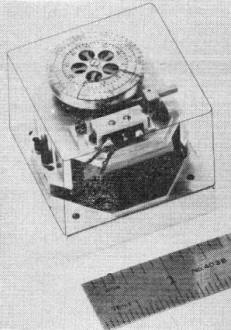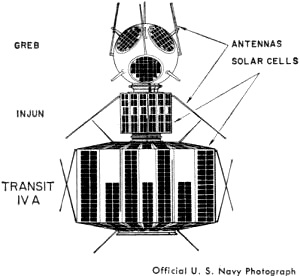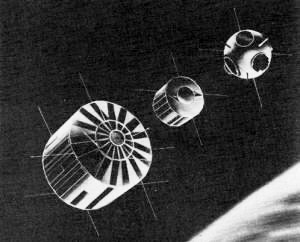|
September 1961 Popular Electronics
 Table
of Contents Table
of Contents
Wax nostalgic about and learn from the history of early electronics. See articles
from
Popular Electronics,
published October 1954 - April 1985. All copyrights are hereby acknowledged.
|
Success won in the
realm of space-based communications has been fraught with many failures. As with
most endeavors, it is thanks to the relative few who have sacrificed and endured
against overwhelming odds to bring significant technological advances in communications
to the many. Space presents a particularly difficult venue because of the harsh
deployment and operational environment, and inaccessibility after deployment. Personal
sacrifice has taken the form of depression, financial ruin, lost opportunity for
other endeavors, broken families, sickness, substance abuse, and other maladies
brought on by an obsession with success. Such sacrifice has built the modern world.
Space Electronics
By Oliver P. Ferrell Editor

It worked - this time! The electronic timer built into Explorer VII failed to
shut off the transmitter on 19.99 mc. in October, 1960. A similar timer installed
in Explorer XI worked perfectly and switched the satellite to a new experimental
program in late May. Explorer XI operates on 107.97 mc. Official U. S. Navy Photograph
Chalk up two failures and one successful launching by the National Aeronautics
and Space Administration since this column last appeared (July issue, page 82).
Included in the failures were the proposed S-45 and S-55 satellites. Successfully
launched and now in orbit is TIROS III.
Backup S-45
The first S-45 was de-scribed in our April column and the back-up S-45 (the reserve
satellite package to be used if the first one failed to orbit - which it did) in
the July column. We followed the possible orbiting of the two S-45's with great
interest, since either one would have been audible to SWL's and experimenters in
space sciences - thanks to the possibility of a strong signal on 20.005 mc. The
earlier S-45 failed to orbit after booster separation caused a malfunction, the
third and fourth stages failing to ignite. Then, on May 24th, much the same thing
happened, although the second stage caused the trouble this time. The demise of
the S-45 program puts an end to the major use of the 20.0-mc. band by American satellites
- at least for 1961.
The S-55
The second NASA failure involved the S-55 satellite - a micrometeoroid detector
developed to measure the hazard of micrometeoroids to space flights. Meteoroids
are material in space - iron, silicates, and other substances - that generally burn
up on entering the earth's atmosphere. They travel at high velocities and may be
more dense than heretofore thought probable. Information is urgently needed not
only on the size and density of micrometeoroids, but also on their speed and penetrating
power - factors that may determine the design of future spacecraft.
The S-55 was to have operated on 136.86 and 136.20 mc. Two separate telemeters
- working independently to enhance reliability - were to have been in nearly continuous
operation for about one year. The launching vehicle was a solid-fuel Scout rocket
whose third stage failed to ignite.
TIROS III
On July 12, NASA successfully launched TIROS III. Designed to take pictures of
cloud formations and measure the infrared heat balance of the atmosphere, TIROS
III has five transmitters in operation. Each of two TV camera systems has a 2-watt
transmitter on 235 mc.: they are triggered into operation by commands from ground
stations. Another 2-watt transmitter - also ground-commanded - is on 237.8 mc. relaying
infrared information. In addition, tracking beacons are on 108.0 and 108.03 mc.
with a power of 30 milliwatts. As this column goes to press, all equipment on TIROS
III is reported to be operating satisfactorily.

Power to operate four of the six transmitters in the June 29 launching comes
from silicon solar batteries. Two transmitters on the Transit IV-A satellite are
powered by a nuclear thermoelectric generator.
Navy Launches 3-on-1
Another newsworthy launching was that of the U. S. Navy's Transit IV-A, INJUN,
and GREB-III, on June 29. The Navy has pioneered launching multiple satellites with
the same rocket, and has been quite successful. This time, the INJUN and GREB-III
did not separate and go into individual orbit, but the navigational satellite, Transit
IV-A, is doing fine.
The Transit program involves transmitters on 54, 324, 162 and 216 mc. The INJUN's
frequency has not been announced, but GREB-III is on 136.20 mc.
At Minus One
The Russians have started publishing numerous semi-scientific articles about
the planet Mars, some of which are obviously designed to catch the interest of the
Soviet man-on-the-street. The first articles came out in the winter of 1960-61 and
others have been appearing in electronics and scientific magazines at an ever-increasing
rate. American observers are readying themselves for an announcement that the Russians
have a satellite on its way to a Martian orbit.
|

On June 29, the U. S. Navy launched three satellites for the
price of one. The artist's drawing below depicts them moments after separation from
the launching vehicle. From left to right are the navigational satellite Transit
IV-A, the INJUN - ready to measure the radiation belts, and the GREB-III, designed
to measure solar radiation. Late reports received as we go to press indicate that
the INJUN and GREB-III did not separate and are probably orbiting while still attached.
|

Bell Telephone scientists study satellite shapes and sizes preparatory
to developing satellites to relay TV and radiotelephone communications. The smaller
model will have about 4000 solar cells; the larger, four feet in diameter, will
hold nearly 12,000 solar cells.
|
Posted December 19, 2019
(updated from original post on 8/18/2014)
|













